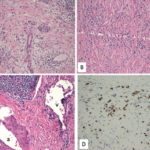Some research suggests that sarcoidosis may stem from a response to an infectious antigen. Mycobacteria and Cutibacteria (formerly Propionibacteria) are the most common of several identified organisms whose DNA and proteins have been identified in sarcoidosis.15 It is, therefore, possible that immune suppression by TNF-α inhibitor therapy results in the proliferation of an infectious organism, which results in noncaseating granuloma formation.13
Interestingly, most sarcoidosis cases associated with TNF-α inhibitors have been attributed to etanercept.5 Also, etanercept has not been shown to be effective in the treatment of sarcoidosis and might actually worsen the disease.16 One hypothesis suggests that this relationship might be related to etanercept’s mechanism of action. Infliximab and adalimumab are monoclonal antibodies that strongly and irreversibly bind to both soluble and transmembrane TNF-α molecules. Conversely, etanercept is a soluble TNF-α receptor that weakly and reversibly binds to the soluble TNF-α molecule and, thus, it has less biological activity.5,17 Further, etanercept has been shown to increase T cell synthesis of interferon-γ, which is an essential player in granuloma formation.11
Sarcoidosis associated with TNF-α inhibitors is reversible in most cases. Decock et al. reported that discontinuation of TNF inhibitors alone has led to an improvement in 86% of cases, and TNF inhibitor discontinuation with the addition of steroids led to improvement or resolution in 95% of cases.12
One could argue that the patient in this case might have had sarcoidosis initially and was misdiagnosed with RA and AOSD. However, the absence of clinical manifestations of sarcoidosis, such as lymphadenopathy, erythema nodosum and ocular involvement, and normal chest radiograph at the time of initial diagnosis may argue against that.
The other consideration, and most supported by the authors, is that the patient had developed an etanercept-induced sarcoid-like reaction. This is supported by the fact that the patient’s clinical improvement was rapid and sustained after the discontinuation of etanercept and the initiation of a short treatment with corticosteroids, with no recurrence of the symptoms after one year.
In Sum
In patients treated with immunosuppressive agents, sarcoidosis can be a challenging diagnosis as many infections can cause similar signs and symptoms. Based on this case, we want to raise awareness that etanercept may be a precipitating factor in the development of sarcoidosis. Further, as reviewed in this report, in such cases, rapid discontinuation of this drug may lead to complete resolution of the clinical symptoms and radiographic findings in a short time.


